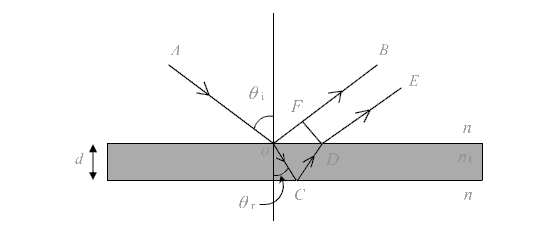Division Of Amplitude
Division of Amplitude: When a light wave (AO) falls on a thin film of material having a different refractive index, it is partially reflected back (OB) and partially transmitted (OC) to the medium. The transmitted wave OC suffers a partial reflection (CD) on the other interface of thin film and another medium. The wave CD after another partial transmission (DE) on the first interface comes out to first medium and is parallel to OE. The two light rays OB and DE are therefore derived from the same parent wave and thus bear a constant phase difference (arising due to different optical paths traveled by wave OB and wave OCDE) and are therefore coherent. However in this process, the energy of incident wave is distributed between different reflected and transmitted components. This process of obtaining two coherent waves is called “Method of division of amplitude”. Depending upon the phase difference between the two waves these may interfere constructively (bright fringe) or destructively (dark fringe)
The path difference between the two waves is
![]() ----------------------------------------(1)
----------------------------------------(1)
If first medium is air (n=1) and the angle of refraction is ![]()
![]() -----------------------------------------------------(2)
-----------------------------------------------------(2)
The ray OB undergoes a phase change of ![]() due to reflection at the upper surface. Thus the total phase difference between the two waves (OB and DE) is given by
due to reflection at the upper surface. Thus the total phase difference between the two waves (OB and DE) is given by

Fig.A:Generation of two coherent waves by division of amplitude.
![]() ----------------------------------------(3)
----------------------------------------(3)
For constructive interference, this phase difference should be even multiple of ![]() , ie. bright fringe will be there if
, ie. bright fringe will be there if
 ----------------------------------------(4)
----------------------------------------(4)
Similarly destructive interference will take place when
![]() ------------------------------------ (5)
------------------------------------ (5)